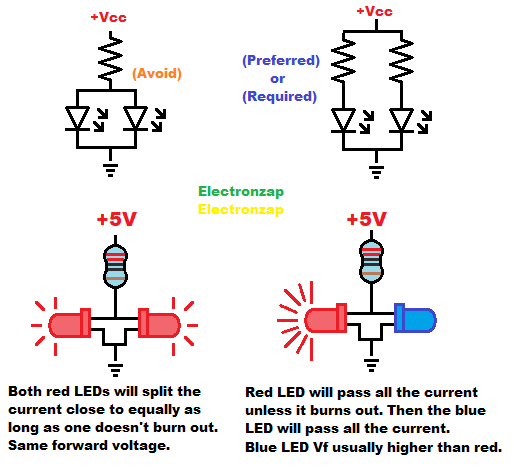Table of Contents
LEDs and other diodes need extra protection when connected in parallel.
You want to give each LED it’s own protective resistor or current source.

If you don’t give each parallel LED it’s own series resistor, then the worst case scenario is that the LED with the lowest forward voltage will get all of the current while the other LED(s) get none. The one getting all the current will likely burn out if the current exceeds the maximum current for one LED. After that, the other LED(s) will get that extra current.
Even if the LEDs have the same forward voltage, sooner or later, one LED may conduct slightly better than another parallel LED. Therefore one LED can easily get more current than the other.
If the parallel LEDs have different forward voltages, then the LED with the lowest forward voltage will definitely get all of the current.
You simply wire each LED and protective resistor as if the others don’t exist. Just remember that the power supply, and any components in series with the parallel LEDs with protective resistors, needs to be able to handle the total current involved.
Good pages to check out next:
To support this site, check out the following links:
- Check out my YouTube videos! https://www.youtube.com/c/Electronzap/videos
- Products I used in my videos or otherwise think look like a good buy. As an Amazon associate, I earn from qualifying purchases. My Amazon affiliate page showing products I think look good
- Information on this site is not guaranteed to be accurate. Always consult the manufacturer info/datasheet of parts you use. Research the proper safety precautions for everything you do.
- Electronzap is a participant in the Amazon Services LLC Associates Program, an affiliate advertising program designed to provide a means for sites to earn advertising fees by advertising and linking to amazon.com.